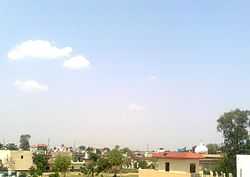Bassi Pathana
| Bassi Pathana ਬੱਸੀ ਪਠਾਣਾ | |
|---|---|
| Historic city | |
|
Bassi Pathana Skyline | |
 Bassi Pathana Location in Punjab, India | |
| Coordinates: 30°42′35″N 76°24′30″E / 30.7097°N 76.4084°ECoordinates: 30°42′35″N 76°24′30″E / 30.7097°N 76.4084°E | |
| Country |
|
| State | Punjab |
| District | Fatehgarh Sahib |
| Established | 1540 |
| Population (2001) | |
| • Total | 18,547 |
| Languages | |
| • Official | Punjabi |
| Time zone | IST (UTC+5:30) |
| PIN | 140412 |
| Telephone code | 01763 |
| Sex ratio | 800:1000 ♂/♀ |
Bassi Pathana is a historical city and a municipal council in Fatehgarh Sahib district in the state of Punjab, India.
Demographics
As of 2001 India census,[1] Bassi Pathana had a population of 18,547. Males constitute 52% of the population and females 48%. Bassi Pathana has an average literacy rate of 77%, higher than the national average of 59.5%; with 54% of the males and 46% of females literate. 10% of the population is under 6 years of age.
History
According to legend, Bassi Pathana was founded in 1540. As the name suggests, it was a city of Muslim Pathans. Bassi Pathana was visited by 9th Sikh master Guru Teg Bahadur Ji and 10th Sikh Master Guru Gobind Singh Ji. There is one Historical Gurdwara (Sikh Temple)in the city in their memory. A Temple of Sh. Namdev ji is also situated in this city. This historic city has one temple named as Brahmghat, where a sage called Rishi Ajgawanand is said to have meditated here for years. During one of those meditaion sessions he accidentally put his leg in the Agni (Fire) which is traditionally lit while meditating. He was so involved in meditation that he did not realize that he had lost his leg in the fire. When his disciples saw that he had lost his leg, they made a leg of wood and brass. He was so delighted with this gesture that he blessed this city and said that no misfortune can ever strike this city. If a misfortune is sensed then this leg (after his death) should be moved through each house and misfortune will go away. Bassi city also had an old railway station which was built during the Britishers rule in India.
Councils
The Town is the block of the District as it contains 86 villages. The City also have its own Municipal Corporation. It had divided the city into Wards (parts) and these each ward has its own representative known as the Municipal Councilor (MC). The mainly the city has approximately 13 Wards.
Religions
The city Population comprises with the three religions Sikhs, Hindu and Muslims.
Basanth Panchami festival
Bassi Pathana people biggest festival is Basanth Panchami. They celebrate this festival in the month of magh (January–February as per Gregorian calendar), due to these festival a big fair is held continuously for three days.
Education
There are mainly three colleges within the city: ITI (Industrial Training Institute) College, S.D.A.V College for Girls, Pine Grove College. As per as the Schooling there are many schools. The most prefers are listed below and they are within the city limits:
| S No. | Name |
| 1 | Holy Heart Public High School Bassi Pathana |
| 2 | Bal Bharti Public School |
| 3 | Bassi Public School (Closed in 2010) |
| 4 | Pine Grove Public School |
| 5 | S.D Public School For Girls |
| 6 | Guru Nanak Dev Public School |
| 7 | Government Senior Secondary School For Girls |
| 8 | Lala Laj Pat Rai High School |
| 9 | Government Senior Secondary School For Boys |
Industry
Bassi Pathana is known for manufacturing of industrial sewing machine parts. India's first sewing machine was manufactured in this historical city in pre-independence era. This factory was established by Pt. Ramji Dass Dhiman in 1925. This factory is situated on Sirhind Road opposite to Block Development Panchayat Office. The famous brand of this factory is "Eye Brand".Bassi pathana is the only city that have a great production for sewing machine and its parts in India. Nowadays the most Famous and Quality Products producers are "M.P." And "Titus" Brands.
References
- ↑ "Census of India 2001: Data from the 2001 Census, including cities, villages and towns (Provisional)". Census Commission of India. Archived from the original on 2004-06-16. Retrieved 2008-11-01.
| ||||||||||
